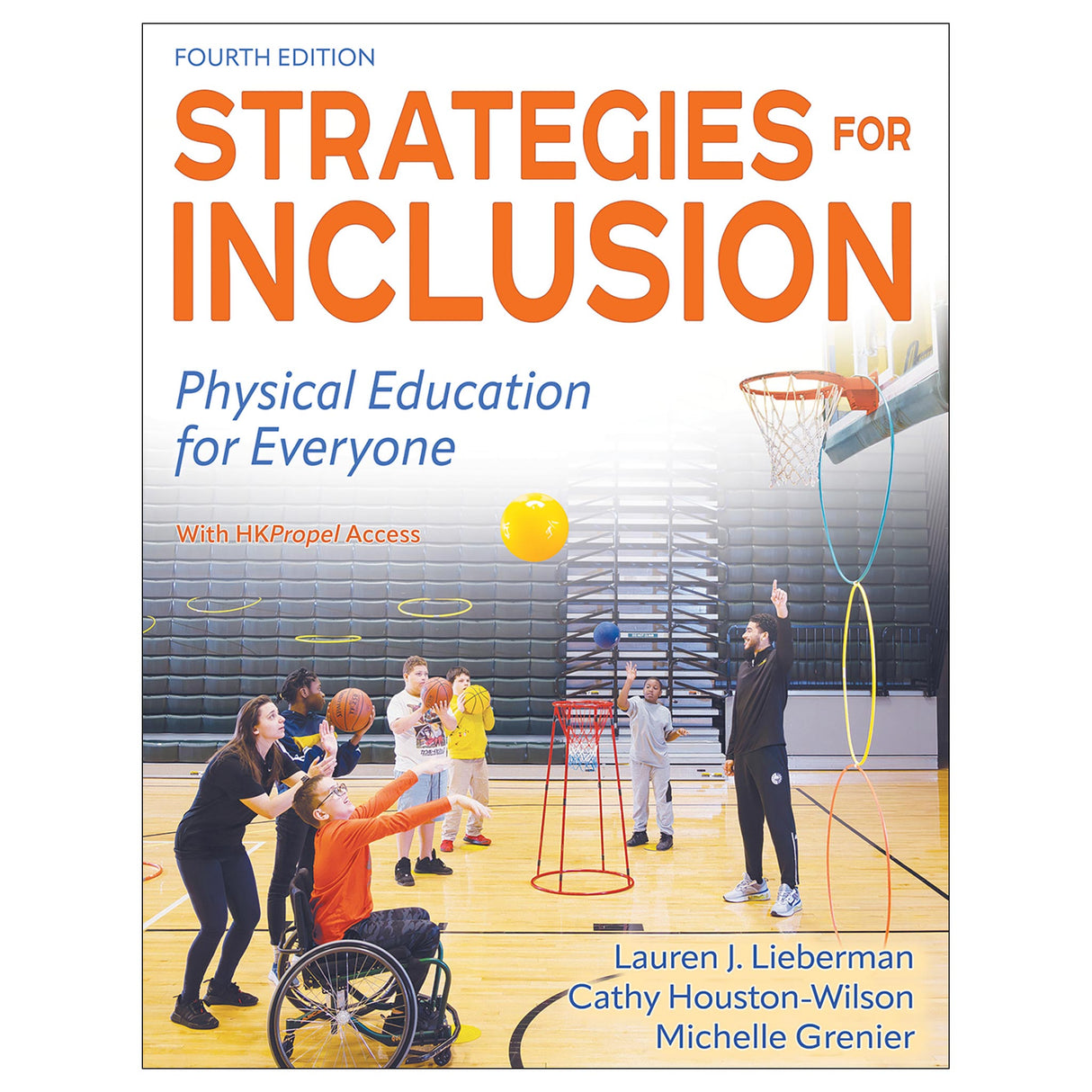Ebook With Online Resource
Strategies for Inclusion 4th Edition Ebook With HKPropel Access
Physical Education for Everyone
$67.00 USD
Unit price
/
Unavailable
Ebook With Online Resource
$67.00 USD
$67.00 USD

Ebook With Online Resource
Since the passage of the Individuals with Disabilities Education Act in 1975, the process of including students with disabilities in general physical education classes has become a reality for school districts. Unfortunately for many students with disabilities, the transition from traditionally segregated classrooms to supportive, inclusive environments has been a continual struggle for all parties involved.
Strategies for Inclusion, Fourth Edition With HKPropel Access, facilitates a smooth transition and continues to raise the bar for successful integration of students with disabilities into general and adapted physical education settings. Its practical and easy-to-implement planning and assessment strategies make this a complete resource for current and future K-12 PE teachers.
The fourth edition provides background information and a clear road map for successful inclusion of students with disabilities in physical education settings. It offers 38 teachable units, complete with assessment tools and step-by-step guidelines for curriculum planning. Each unit contains an assessment rubric and provides ideas on how to incorporate objectives from the student’s individualized education plan (IEP). Adaptations and accommodations are also included in each unit and are divided into the categories of environment, equipment, instruction, and rules. The inclusive curriculum includes the following:
Each chapter of the text includes an opening scenario designed to help the reader explore their thoughts and feelings regarding various aspects of inclusion and adapted physical education. Teaching tips and ready-to-use forms, charts, and strategies are included, as well as a brand-new chapter on interdisciplinary and transdisciplinary collaborative practices to promote student engagement. In places where the SHAPE America National Standards for K-12 Physical Education are mentioned, they have been updated to the latest revision of the standards.
In addition, the fourth edition now offers five ready-to-use PowerPoint training modules, delivered in HKPropel, that instructors or administrators can use for in-service workshops for their students or staff. Teachers will be empowered to advocate for themselves and their students with disabilities to receive the necessary supports that enable all students to lead a healthy and active lifestyle. The training module topics include
Strategies for Inclusion offers the most up-to-date and useful strategies to include children with disabilities in physical education classes. With it, physical and adapted physical educators will help empower all students with the knowledge that anything is possible and that their goals can be achieved through understanding, cooperation, and creativity.
Note: A code for accessing HKPropel is included with this ebook.
Strategies for Inclusion, Fourth Edition With HKPropel Access, facilitates a smooth transition and continues to raise the bar for successful integration of students with disabilities into general and adapted physical education settings. Its practical and easy-to-implement planning and assessment strategies make this a complete resource for current and future K-12 PE teachers.
The fourth edition provides background information and a clear road map for successful inclusion of students with disabilities in physical education settings. It offers 38 teachable units, complete with assessment tools and step-by-step guidelines for curriculum planning. Each unit contains an assessment rubric and provides ideas on how to incorporate objectives from the student’s individualized education plan (IEP). Adaptations and accommodations are also included in each unit and are divided into the categories of environment, equipment, instruction, and rules. The inclusive curriculum includes the following:
- 10 elementary units for basic skills such as balance and object control
- 11 sport units for team sports such as basketball and golf
- 5 health and fitness units, including swimming and weight training
- 12 recreation and life skills units such as paddleboarding and dancing
Each chapter of the text includes an opening scenario designed to help the reader explore their thoughts and feelings regarding various aspects of inclusion and adapted physical education. Teaching tips and ready-to-use forms, charts, and strategies are included, as well as a brand-new chapter on interdisciplinary and transdisciplinary collaborative practices to promote student engagement. In places where the SHAPE America National Standards for K-12 Physical Education are mentioned, they have been updated to the latest revision of the standards.
In addition, the fourth edition now offers five ready-to-use PowerPoint training modules, delivered in HKPropel, that instructors or administrators can use for in-service workshops for their students or staff. Teachers will be empowered to advocate for themselves and their students with disabilities to receive the necessary supports that enable all students to lead a healthy and active lifestyle. The training module topics include
- assessments,
- universal design for learning,
- Lieberman-Brian Inclusion Rating Scale for Physical Education (LIRSPE) intervention,
- paraeducator training, and
- peer training.
Strategies for Inclusion offers the most up-to-date and useful strategies to include children with disabilities in physical education classes. With it, physical and adapted physical educators will help empower all students with the knowledge that anything is possible and that their goals can be achieved through understanding, cooperation, and creativity.
Note: A code for accessing HKPropel is included with this ebook.
Audience
Audiences: Undergraduate and graduate students in physical education, adapted physical education, recreation, and special education courses; also K-12 and special education teachers, recreation directors, and therapeutic recreation specialists. Part I. Understanding Inclusion
Chapter 1. Inclusion in Physical Education
Legislative Mandates: A Historical Perspective
Placement Options in Physical Education
Roles and Responsibilities of General Physical Education Teachers
Roles and Responsibilities of Adapted Physical Education Specialists
Benefits of Including Students With Disabilities With Their Peers
Summary
Chapter 2. Assessment: The Cornerstone of Effective Instruction
Features of Effective Assessment
Traditional Assessment Techniques
Authentic Assessment
Alternative Assessment
Summary
Chapter 3. The Placement Process in Physical Education
Physical Education Placement Challenges
Special Education Process
Dignity of Risk
Assessing the Placement
The Lieberman-Brian Inclusion Rating Scale for Physical Education
Summary
Chapter 4. Individualized Education Plans
The IEP Process
The Role of Assessment in IEPs
Components of the IEP
Electronically Generated IEPs
Physical Educator’s Role in the IEP Process
Incorporating Goals and Objectives Into the General Physical Education Class
Summary
Chapter 5. Collaborative Practice That Promotes Student Engagement
Nuts and Bolts of Collaboration
Overcoming Barriers to Collaborative Participation
Getting a Place at the Table
Steps in the Collaborative Process
Practical Applications to the Collaborative Process
Coteaching as a Practice for Working With the APE or GPE Teacher
Summary
Chapter 6. Positive Interventions to Manage Behaviors and Increase Student Performance
Strategies to Identify and Avoid Behavior Challenges
Understanding the Reasons for Inappropriate Behavior
Interventions and Strategies to Improve Behavior
Strategies to Decrease or Redirect Inappropriate Behavior
Summary
Chapter 7. Universal Design for Learning
Universal Design in Physical Education
Self-Advocacy
Differentiation, Adaptions and Accommodations
Process of Adapting Activities
Types of Adaptation
Infusing the Paralympics Into the Curriculum
Summary
Chapter 8. Support Personnel
Peer Tutors
Paraeducators
College Students
Summary
Chapter 9. Transition Planning
Dr. Amaury Samalot-Rivera
Transition Services and the IEP
Functional Approach in Transition Planning
Transition Activities for Effective Social Inclusion
Assessment in Transition
Summary
Part II. Strategies for Inclusion
Chapter 10. Basic Skills
Balance
Body Awareness
Hula-Hoop Activities
Jump Rope
Locomotor Skills
Cooperative Games
Object Control Skills
Parachute Activities
Rhythmic Skills
Scooter Board Activities
Chapter 11. Sport Skills
Softball
Volleyball
Basketball
Soccer
Tennis
Badminton
Flag Football
Golf
Track and Field
Gymnastics
Wrestling
Chapter 12. Health and Fitness
Swimming
Aerobics
Weight Training
Cross-Country Skiing
Fitness Activities
Chapter 13. Recreation and Life Skills
Backpacking and Hiking
Bowling
Fishing
Rock Climbing
Skating and In-Line Skating
Canoeing
Line Dancing
Martial Arts
Yoga
Dancing
Spikeball
Paddleboarding
Appendix A. Teachers’ Guide to Helping Students Appreciate Their Peers With Disabilities
Appendix B. Special Education Terminology
Appendix C. Brockport Aquatic Skills Checklist
Appendix D. Parent and Teacher IEP Checklist for Physical Education
References
Index
Chapter 1. Inclusion in Physical Education
Legislative Mandates: A Historical Perspective
Placement Options in Physical Education
Roles and Responsibilities of General Physical Education Teachers
Roles and Responsibilities of Adapted Physical Education Specialists
Benefits of Including Students With Disabilities With Their Peers
Summary
Chapter 2. Assessment: The Cornerstone of Effective Instruction
Features of Effective Assessment
Traditional Assessment Techniques
Authentic Assessment
Alternative Assessment
Summary
Chapter 3. The Placement Process in Physical Education
Physical Education Placement Challenges
Special Education Process
Dignity of Risk
Assessing the Placement
The Lieberman-Brian Inclusion Rating Scale for Physical Education
Summary
Chapter 4. Individualized Education Plans
The IEP Process
The Role of Assessment in IEPs
Components of the IEP
Electronically Generated IEPs
Physical Educator’s Role in the IEP Process
Incorporating Goals and Objectives Into the General Physical Education Class
Summary
Chapter 5. Collaborative Practice That Promotes Student Engagement
Nuts and Bolts of Collaboration
Overcoming Barriers to Collaborative Participation
Getting a Place at the Table
Steps in the Collaborative Process
Practical Applications to the Collaborative Process
Coteaching as a Practice for Working With the APE or GPE Teacher
Summary
Chapter 6. Positive Interventions to Manage Behaviors and Increase Student Performance
Strategies to Identify and Avoid Behavior Challenges
Understanding the Reasons for Inappropriate Behavior
Interventions and Strategies to Improve Behavior
Strategies to Decrease or Redirect Inappropriate Behavior
Summary
Chapter 7. Universal Design for Learning
Universal Design in Physical Education
Self-Advocacy
Differentiation, Adaptions and Accommodations
Process of Adapting Activities
Types of Adaptation
Infusing the Paralympics Into the Curriculum
Summary
Chapter 8. Support Personnel
Peer Tutors
Paraeducators
College Students
Summary
Chapter 9. Transition Planning
Dr. Amaury Samalot-Rivera
Transition Services and the IEP
Functional Approach in Transition Planning
Transition Activities for Effective Social Inclusion
Assessment in Transition
Summary
Part II. Strategies for Inclusion
Chapter 10. Basic Skills
Balance
Body Awareness
Hula-Hoop Activities
Jump Rope
Locomotor Skills
Cooperative Games
Object Control Skills
Parachute Activities
Rhythmic Skills
Scooter Board Activities
Chapter 11. Sport Skills
Softball
Volleyball
Basketball
Soccer
Tennis
Badminton
Flag Football
Golf
Track and Field
Gymnastics
Wrestling
Chapter 12. Health and Fitness
Swimming
Aerobics
Weight Training
Cross-Country Skiing
Fitness Activities
Chapter 13. Recreation and Life Skills
Backpacking and Hiking
Bowling
Fishing
Rock Climbing
Skating and In-Line Skating
Canoeing
Line Dancing
Martial Arts
Yoga
Dancing
Spikeball
Paddleboarding
Appendix A. Teachers’ Guide to Helping Students Appreciate Their Peers With Disabilities
Appendix B. Special Education Terminology
Appendix C. Brockport Aquatic Skills Checklist
Appendix D. Parent and Teacher IEP Checklist for Physical Education
References
Index





